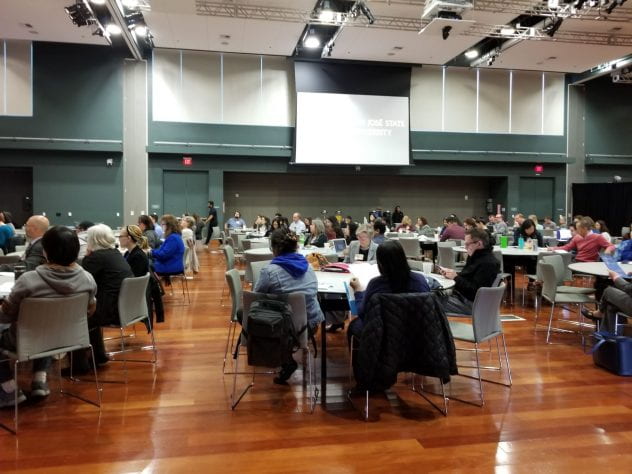
Students and faculty share their experience with service learning projects through CommUniverCity at the Student Success Symposium April 15.
San Jose State University hosted its 2nd Annual Student Success Symposium April 15, with more than 260 faculty, staff and students from SJSU, other California State University campuses and community colleges.
The event featured two keynote speakers who discussed serving first-generation and diverse student populations as well as 20 breakout sessions around topics ranging from developing flipped classrooms, service learning programs, peer education and more. The symposium was sponsored by the Division of Academic Affairs, the Division of Student Affairs, a Department of Education First in the World Grant and a Department of Education Project Succeed grant.
Professor Patricia Backer, who served on the executive committee for the symposium, started the day-long event with a brief call to order before introducing SJSU President Mary A. Papazian.
Student success means “developing students who will become innovators and creative forces in our economy,” said SJSU President Mary Papazian, during her welcome remarks. “It means our students have the confidence and the tangible skills they need not only for their first professional job, but their next job after that.”
Innovating New Classroom Models

Associate Professor Laura Sullivan-Green leads a discussion about flipped classroom models. She and a team of faculty at three CSUs are researching the teaching method’s ability to improve learning outcomes in gateway STEM courses.
Laura Sullivan-Green, an associate professor of civil and environmental engineering and Ravisha Mathur, chair of child and adolescent development, hosted a break out session about their research on flipped classroom models. As recipients of a First in the World Grant, SJSU faculty are collaborating with colleagues across three CSUs to create active learning models for gateway science, technology, engineering and math (STEM) courses with historically low success rates. In a flipped course, students are exposed to content before they come to the classroom and during in-person class sessions faculty members act as facilitators and provide clarification of the content students studied on their own. These two steps are followed up with post-class work that includes reflection, complex practice and advanced work.
“Students can be nervous about learning before they come to class,” said Sullivan-Green. “But once they get the structured, they are engaged with it.”
To launch their session, they asked participants to write down ideas about how to connect with industry professionals. After a few moments, they called everyone back to their seats and looked over the lists.
“All these things are active,” Sullivan-Green said. “Not one said sit and listen to a professor. So this is a wonderful way to segue into our presentation.”
Since receiving the grant in 2015, the principal investigators on the grant have created faculty learning communities, held regular discussions and offered summer training sessions to support faculty in moving to a flipped class room model that promotes active learning. They have been focused on a calculus course that was identified as a bottleneck for STEM majors, that had success rates as low as 40 percent. Now that the course has been piloted, the final phase of the grant will include comparing it to traditional courses.
“We have an external evaluator who will be looking at every factor for student success to determine if students are more engaged,” Mathur said.
During their presentation, Mathur and Sullivan-Green asked faculty members who attended to brainstorm what types of pre and post activities they might use in their own courses as well as what in-class activities would work.
One professor noted that it was important to think about learning outcomes for each module, and not just providing activities to keep students busy.
They closed the session with tips on finding source material for pre-class sessions including simulations, podcasts, text books, trade magazines, academic blogs, simple experiments or assignments to engage with people who work in a specific field.
Engaging in the Community

More than 260 higher education professionals and students attended SJSU’s Second Inaugural Student Success Symposium April 15.
In another breakout session, students and faculty from CommUniverCity presented their experiences engaging in the community.
Alex Dahl, a master’s student in environmental studies, is engaged with the project “Growing Sustainably: Garden Education and Garden Club.
“I am the link between the elementary school students, SJSU students and the community partners,” she said.
Always passionate about elementary education, she said the project has helped open her eyes to the importance of offering environmental and outdoor activities for K-12 students.
“I realized how many people are living with no way to access true outdoor experiences,” she said. “I am studying this as part of my thesis.”
Michael Oye, a lecturer in material and chemical engineering serves as a faculty advisor for CommUniverCity projects.
“Students get a chance to design their own projects, work in groups and go out and do something good,” he said. “It helps them get engaged with their majors and it’s also good for the community.”
The symposium executive committee included Patricia Backer; Sullivan-Green; Gregory Wolcott, interim AVP for transition and retention services; and Stacy Gleixner.
View the full list of breakout sessions and speakers online.
